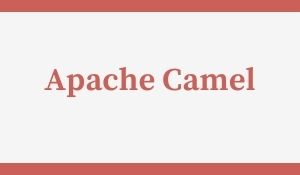
Introduction to Apache Camel:
Apache Camel is an information based middleware with a rule-based routing and mediation engine, which simplifies the integration of Enterprise applications. Based on domain-specific language, Camel can be used to configure routing- and mediation rules. This tool uses Java as its programming language and is platform-independent, thus making it compatible with all operating systems.
Apache Camel is a Java-based Open Source framework for converting domains and for rule-based routing. The software is used especially in huge enterprises and for complex network structures. It supports numerous functions, like Bean Binding for Plain Old Java Objects and JavaBeans, thus making it simple to integrate into many other applications such as the Dependency Injection Framework Spring or in Google Guice.

Apache Camel is presently one of the most powerful tools to enable Enterprise integration patterns. These patterns are essentially the process and ways of organizing the solutions to a problem and not the solutions themselves. They relate to the procedure of documenting a set of patterns and blueprints which could be used to design a huge system of Apache camel components in the best possible manner. It defines which components can be provided to run on the same method or subsystems and which on various subsystems or machines.
Basic things in Apache Camel were discussed below.
•Routing and Mediation: This is used to Sending, receiving, routing and transforming data.
•Enterprise Integration patterns: The Integration of Enterprise functions in business applications.
•Compatibility: The Communications with other transport- and message protocols through Uniform Resource Identifiers (URI).
Key Benefits of Apache Camel:
The benefits of Apache Camel are:
•Rules Engine: The Definition of routing and mediation rules with Java, Scala or Spring XML configuration.
•Uniform Resource Identifiers: URI utilization allows communications with various transport and messaging protocols such as HTTP, JMS and AMQP.
•Domain-Specific Languages: It is easy to operate the domain-specific language for connection to Enterprise integration patterns and transports.
•API Connectivity: It provides connectivity to numerous transport protocols and APIs.
•Bean Binding: The seamless integration of popular frameworks like CDI, Spring, Blueprint and Guice.
•SOA Infrastructure: Apache Camel is suited for Service-oriented architecture (SOA) with the distributed services.
•Platform-independent: Apache Camel is platform-independent and can easily be used with every operating system.
•Java-based: This tool is based on Java and is therefore suited for integration into Java applications with minimal dependencies.
•Open Source Community: Camel is an Apache brand product with a large, active Open Source Community.
Features of Apache Camel:
Here are some of the most main features of Camel that you would find useful in enhancing the camel applications:
•Camel assists pluggable data formats and type converters for such information transformations, so new formats and converters can be added in future. Presently, it assists many popular formats and converters; to name a few – CSV, EDI, JAXB, JSON, XmlBeans, XStream, Flatpack, Zip.
•This technology assists pluggable languages to write predicates in DSL. Some of the supported languages include JavaScript, Groovy, Python, PHP, Ruby, SQL, XPath, XQuery.
•Camel assists the POJO model so that you can plug in Javabeans at various points.
•This tool eases testing of such large distributed and asynchronous systems by using messaging.
Latest Developments:
when you have to develop the performance of a Camel application. Then, go through a checklist, do small incremental changes assisted by measurements until you get to a desired state. And rather than focusing on micro optimizations and hacks, have an holistic view of the system, get the design right, and begin tuning from the host system, to JVM, Camel Context, routing elements, endpoints and the information itself. By using familiar patterns, and principles with focus on easy and scalable design is always a good beginning.

Market Share of Apache Camel:
Apache Camel has a market share of about less than 0.01 percent. As per the recent survey analysis, An Apache Camel professional is paid around $115k. GoLogica crafted the course syllabus which gives basic to advanced levels of expertise on Apache Camel Training.
Here, you can get quality content regarding Apache Camel Training. This syllabus will be more than enough to appear for certification and interviews confidently. We provide the best Apache Camel online training with highly professionals who have more than 18-20+ years of experience. Our team of experts is available to help you in learning Apache Camel online by providing continuous support.










